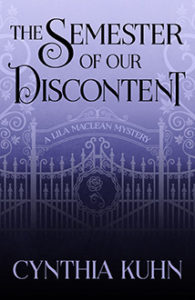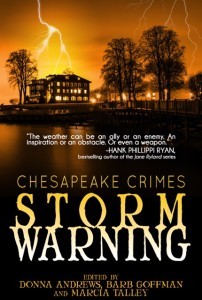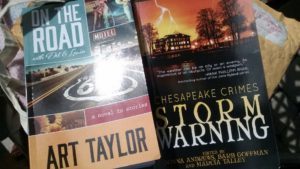Art Taylor's Blog, page 84
July 4, 2016
SleuthSayers: Interview with Ariel S. Winter
Ariel S. Winter’s Twenty-Year Death was a tremendous achievement and a tremendously enjoyable book—three books, in fact, a trilogy of crime novels published in a single volume in 2012. When Winter returned this spring with his next book, he took his work in an entirely different direction: a domestic novel of sorts crossed with science fiction. I had the chance to interview Winter about that book, Barren Cove, over at SleuthSayers. Here’s a sample from our exchange.
ART TAYLOR: Barren Cove clearly signals a shift in genre, with its futuristic setting, with robots as the primary characters, even in the labeling with “science fiction” mentioned prominently in one of the back cover blurbs. Have you been as big a reader and a fan of science fiction as you are of mystery fiction? Are there specific authors here, as with The Twenty-Year Death, that was an influence?
ARIEL S. WINTER: I became a writer because of my great love of reading, and as a reader I’ve never limited myself to specific genres. Especially as a kid, I read fantasy, science fiction, mystery, comedy, literary fiction, pretty much anything my parents or librarians recommended, plus whatever I stumbled on myself. And lots and lots of comic books. Since all of those genres fueled my love of fiction, and my writing grew out of my love of fiction, it only makes sense that my writing encompasses all of the things that turned me into a writer in the first place.
Growing up, I read the classics, Asimov, Bradbury, Clarke, Douglas Adams, several of whom I pay homage to in Barren Cove through characters’ names. Then as I got older I moved on to Philip K. Dick, Jonathan Lethem, Alfred Bester, Thomas M. Disch, and I’m still filling in some of the gaps in my reading. I finally read the Dune books last year and was blown away.
As for influence on Barren Cove, it’s less about style, and more about world building. I imagined that all robot fiction up to now takes place in a shared universe, so that the great robot books are detailing a continuous history. In R.U.R. by Karel Capek, the action takes place exclusively in a factory where robots are just first starting to be manufactured. By I, Robot, robots are an integral part of human life, but the laws of robotics put limits on their actions, and helps to keep them separate from humans. In Do Androids Dream of Electric Sheep? robots are indistinguishable from humans, even passing as human, and they are pervasive, but they’re supposed to still be inferior socially. Barren Cove is the next book in that history, the point at which robots are now the majority, and humans are second-class.
Read the full interview here.
June 30, 2016
More Road Trips!
After the post earlier this week about my book’s recent travel troubles, I thought I’d offer some more positive news on road trips—including a contest I came across!
Southern Living is hosting a contest for a 9-night road trip with stops at the winner’s choice of three hotels from the magazine’s hotel collection—plus a $500 gift card! I’ve already signed up and keeping my fingers crossed for fun times ahead. Enter here yourself.
In other news, both Travel & Leisure and Condé Nast Traveler have offered articles and slideshows on popular and iconic road trips—great photos and descriptions throughout!
“Six Truly Iconic American Road Trips” from Travel & Leisure—including Del & Louise’s own travels from Taos to Albuquerque in the #5 slot!
“America’s Best Road Trips” from Travel & Leisure
“10 Iconic American Road Trips” from Condé Nast Traveler (from which the featured image above is borrowed)
The Washington Post has also offered a fun twist on this—noting the summer’s lower gas prices compared to years past and calculating how far $100 in gas might take drivers from our home base in the DC area. Of the five trips offered there, I think Key West would be my own destination of choice.
Happy travels! Or at the very least: happy dreaming about travels!
June 27, 2016
How On the Road Went On the Road Itself
Back in late May, Sheri Sorvillo—a great friend of mine and Tara’s—asked if we would send her signed copies of her books, a request we were happy to oblige! I autographed a copy of On the Road with Del & Louise, my wife signed her new book Bystanders, and then Tara packaged them up, bubble wrap and everything, and sent them on their way to Florida, where Sheri now lives.
Here’s what Sheri received.


At first, despite the letter and the packaging, Sheri was relieved. “It’s OK,” she texted us. “It just looks like someone read Tara’s book!”
When Tara texted, “Did a bear get it? It was wrapped in bubble wrap,” Sheri replied with photos showing just the slightest fraying at one corner of the cover.
But when I texted, “How’d mine pull through? Did no one at the post office want to read it? ;-)” Sheri’s good mood turned troubled.
“Please please don’t tell me yours wasn’t in the same package.”
As I said, it had been—of course.
Because we hadn’t bought insurance, the lost copy wouldn’t be covered by the postal service (more on that in a second), so I simply promised to send Sheri a replacement copy. Sheri, in turn, insisted on paying for both copies (the lost one and the replacement one). I insisted that the loss wasn’t her responsibility; she insisted it wasn’t mine either. And somewhere in between texts and checks, I ended up sending her not only another copy of Del & Louise but also a copy of the new Chesapeake Crimes anthology too.
As before, I signed, packaged (in a padded envelope), and mailed. At the counter, I thought about adding insurance to the package, but then told myself Nah, what are the chances of lightning striking twice in the same place?
And then I started watching the tracking page (see the image above) as the package headed down to Florida—and then took an abrupt turn to the Midwest, to Hazelton, Missouri, a sort facility which had been called “the Black Hole” of the postal system in one online conversation I discovered.
I could go through the many thoughts that careened through my mind: frustration at the postal service, frustration with myself for not buying insurance, concern about how much all this was costing all of us, anxiety about each new update on the tracking page, anticipation of the customer service I’d receive when I called to complain… right on down the line, even when the tracking page said the package had returned to Florida and then departed again soon after—for destinations unknown. Back to Hazelton again?
Fortunately, the package finally arrived safely—and Sheri’s photos of the books on her end were a big relief on this one.
Here’s hoping that next mailings don’t decide to take any similar detours as well!
Save
Save
Save
Save
June 20, 2016
Readings…with Kids
Over the last week, both my wife Tara Laskowski and I have had one piece of writing brought up time and again in conversation—and it’s not a work of fiction by either of us.
Online, in emails, and in person, many people have commented—always positively and sometimes with great enthusiasm—about Tara’s article “Children Allowed?” in Publisher’s Weekly last week (published online here as “Why Parents Should Take Their Children to Literary Readings”).
The subject came up several times in conjunction with Tara’s recent reading at the Osterhaut Free Library in her hometown of Wilkes-Barre, Pennsylvania. The librarian hosting the reading and I talked about it after she very nicely provided our son Dash with some popcorn and lemonade; a new friend in the publishing industry, also a Wilkes-Barre native and a new mom herself, congratulated Tara on the essay and asked if she was interested in writing more on parenting (possibilities, Tara?); and then when I shared the picture here on Facebook, several comments echoed about Dash’s photobomb in the corner and about his string of literary appearances. I couldn’t help but have the article on my own mind throughout the event—with an equal mix of pride and self-consciousness—as Dash kept getting up from his chair for a sip of lemonade, and to examine the podium where his mom was reading, and to pass out bookmarks to late-comers, and….
Just a quick suggestion for anyone reading this to check out Tara’s article itself—a good one, I clearly think, and one that touches on subjects close to my own heart too. And you can also catch Tara (and Dash (and me too!)) at other events this week, including:
Politics and Prose reading, with Michael Landweber, Saturday, June 25, 1 p.m. at Politics and Prose, 5015 Connecticut Avenue NW, Washington, DC
Grubb Road Book Festival, Sunday, June 26, 2-5 p.m., The Daily Dish, 8301 Grubb Road, Silver Spring, MD
In other news, I published a quick blog post on Friday at Criminal Minds in answer to the question “If you could host a dinner party where the guests didn’t actually have to be alive, which three writers would you invite?” As I respond in the title of my post, “Our Dining Room Table Actually Seats Six.” Check it out to discover an eccentric guest list, promising a dynamic (and maybe sometimes difficult) dinner party ahead.
June 13, 2016
EQMM‘s Department of First Stories
A new issue of Ellery Queen’s Mystery Magazine is generally a cause for excitement, but the July 2016 edition seems particularly special. As part of the magazine’s ongoing 75th year celebrations, EQMM turns the focus toward its ongoing “Department of First Stories,” which became a regular feature of the magazine in 1949, and this latest issue publishes fresh stories by several writers who debuted here over the years, including Steven Saylor, David Morrell, Nancy Pickard, Percy Spurlark Parker, David Dean, Trina Corey, Brendan DuBois, Martin Edwards, and Laura Benedict—and, of course, publishes a debut author as well: John H. Sherman, who enters the Department of First Stories with “Black Monday.”
As a special feature, mystery critic and historian Marvin Lachman reviews the history of EQMM‘s commitment to new writers, from even before this became a regular part of the magazine, and offers a list of “Distinguished Alumni/ae of The Department of First Stories.” It’s an impressive list, including (in order of debut publication) James Yaffe, Harry Kemelman, Jack Finney, Stanley Ellin, William Link & Richard Levinson, Robert L. Fish, James Powell, Jon L. Breen, Francis M. Nevins, Dick Lochte, Charles Ardai, and Meredith Cole—just to sample the many authors included beyond the ones already named above!
I’m proud that my own first mystery story was part of this roll call—”Murder on the Orient Express” in December 1995 (#48 in Lachman’s list here!)—and thrilled to be in such distinguished company generally, part of such an amazing history.
Check out the new issue both for a reminder of EQMM‘s importance in introducing and encouraging new writers and for some great new fiction too!
June 11, 2016
On the Road Named a Macavity Award Finalist
Such thrilled news today: After winning the Agatha Award and being named a finalist for the Anthony, On the Road with Del & Louise has now been named a finalist for the Macavity Award as well!
Thanks so much to Janet Rudolph, to Mystery Readers International, and to Mystery Readers Journal for hosting the awards and for all the support. Here’s the complete list of finalists (linked and below)—and congrats to everyone, particularly so many of my friends throughout the categories here!
Best Mystery
Little Black Lies by Sharon Bolton (Minotaur)
The Long and Faraway Gone by Lou Berney (Morrow)
The Hot Countries by Tim Hallinan (Soho)
The Child Garden by Catriona McPherson (Midnight Ink)
Life or Death by Michael Robotham (Mulholland)
The Cartel by Don Winslow (Knopf)
Best First Mystery
Concrete Angel by Patricia Abbott (Polis)
Past Crimes by Glen Erik Hamilton (Morrow)
The Killing Kind by Chris Holm (Mulholland)
Where All Light Tends to Go by David Joy (Putnam)
The Unquiet Dead by Ausma Zehanat Khan (Minotaur)
On the Road with Del and Louise by Art Taylor (Henery)
Best Critical/Biographical
The Golden Age of Murder: The Mystery of the Writers Who Invented the Modern Detective Story by Martin Edwards (HarperCollins)
A Is for Arsenic: The Poisons of Agatha Christie by Kathryn Harkup (Bloomsbury Sigma)
Meanwhile There Are Letters: The Correspondence of Eudora Welty and Ross Macdonald, edited by Suzanne Marrs & Tom Nolan (Arcade)
Forensics: What Bugs, Burns, Prints, DNA, and More Tell Us About Crime by Val McDermid (Grove)
The Lost Detective: Becoming Dashiell Hammett by Nathan Ward (Bloomsbury)
Best Short Story
“The Little Men” by Megan Abbott (MysteriousPress.com/Open Road)
“On Borrowed Time” by Mat Coward (Ellery Queen’s Mystery Magazine, June 2015)
“Sob Sister” by Loren D. Estleman (Detroit Is Our Beat: Tales of the Four Horsemen, Tyrus)
“A Year Without Santa Claus” by Barb Goffman (Alfred Hitchcock’s Mystery Magazine, January/February 2015)
“Quack and Dwight” by Travis Richardson (Jewish Noir, ed. Kenneth Wishnia, PM Press)
“A Joy Forever” by B.K. Stevens (Alfred Hitchcock’s Mystery Magazine, March 2015)
Sue Feder Historical Mystery Award
The Masque of a Murderer by Susanna Calkins (Minotaur)
A Gilded Grave by Shelley Freydont (Berkley Prime Crime)
Tom & Lucky (and George & Cokey Flo by C. Joseph Greaves (Bloomsbury)
The Lady from Zagreb by Philip Kerr (Putnam)
Secret Life of Anna Blanc by Jennifer Kincheloe (Seventh Street)
Dreaming Spies by Laurie R. King (Bantam)
June 10, 2016
SleuthSayers: The Complete Continental Op
Julie M. Rivett, Dashiell Hammett’s granddaughter and a great Hammett scholar, chatted with me at SleuthSayers about her latest project, gathering all of the standalone Continental Op stories for their first e-book publication—and their first-ever publication together in an English language edition of any kind.
Here’s a quick exchange from the interview.
ART TAYLOR: Hammett’s characters Sam Spade and Nick and Nora Charles have surely entered the wider cultural consciousness more completely, but the Continental Op might arguably be the more seminal character in terms of the development of the genre. What do the Op and his stories offer crime fiction readers that The Maltese Falcon, for example, doesn’t?
JULIE M. RIVETT: The Op is important and, yes, seminal. Ellery Queen said he could have been Sam Spade’s older brother, equally hardbitten, but with perhaps less spectacular presentation. The Op’s narratives are workmanlike, realistic, and procedurally detailed. His plainspoken wit is at least as dry as Spade’s. It’s a shame he’s not memorialized in film the way that Sam and Nick and Nora are. I think that’s the main reason the Op is less well known to contemporary readers.
One of other the big differences between the Op and Spade, Nick, and Ned Beaumont is that he’s a company man, on the payroll for the Continental Detective Agency, modeled on Pinkerton’s National Detective Agency, where my grandfather worked for some five years, off and on. Spade and Nick Charles are independent sleuths. Ned Beaumont functions as a detective, but in fact he’s a political operator inadvertently entangled in a murder. Professional standpoint makes a difference in how each one perceives his professional obligations. The Op is the only one who has to answer to a boss, the Old Man. He fudges his reports at times to cover up some less than conventional tactics, but, still, he’s loyal to the Agency and he loves his job. Or he is his job. That idea of profession as identity runs all through my grandfather’s work. The Op tales offer an extended narration of workaday professionalism in action.
June 6, 2016
Digest Enthusiast and Upcoming Events
I was thrilled when editor Richard Krauss reached out to interview me for the latest issue of The Digest Enthusiast and I’m thrilled now to have the magazine in hand myself. The Digest Enthusiast covers pulp and digest magazines of years past and those still carrying on the tradition today, including Ellery Queen’s Mystery Magazine, where many of my own stories have appeared. In addition to the interview with me, the new issue of The Digest Enthusiast also includes interviews with the editors of the “new generation of digital digests,” including Alec Cizak of Pulp Modern, Jennifer Landels of Pulp Literature, John Kenyon of Grift, Kristen Valentine of Betty Fedora, and Sheri White of Morpheus Tales; features on the Galaxy Science Fiction Novels, on “Criswell Predicts” and the digests Fate and Spaceway, and on Pocket Pin-Ups trading cards; fiction by writers including Gary Lovisi and Ron Fortier; and a mix of other articles, reviews, and more. For the full list of contents or to get your own copy, either digital or in print, check out The Digest Enthusiast‘s website here.
(And hey, I’m planning to give away a copy of this issue and other items soon too, as part of my new quarterly newsletter; sign up here.)
Recent Publications
 Online recently, I’ve written a couple of different pieces, including:
Online recently, I’ve written a couple of different pieces, including:
At SleuthSayers: An update on reading Raymond Queneau’s Exercises in Style (preview: I finally put it aside)
At Criminal Minds: A discussion of collaborative writing (including a take-down of a disappointing episode of Columbo)
At the Washington Independent Review of Books: A discussion of academic mysteries (including shout-outs to writer friends whose books I’ve recently read, Cynthia Kuhn and B.K. Stevens)
Upcoming Events
Beyond my appearance in The Digest Enthusiast and those articles/blog posts online, a number of events ahead will keep me physically on the move—including a couple that aren’t public, like my 30th high school reunion (30th? yikes!) and a cookout with members of a local book group who have been reading On the Road with Del & Louise. Between and around those, here’s where you can find me over the next week:
 Monday, June 6—that’s today as this post first goes live!
Monday, June 6—that’s today as this post first goes live!
Reading with Tara Laskowski, Talbot County Free Library, 100 West Dover Street
Easton, Maryland • 6 p.m.
Saturday, June 11
Panel: Chesapeake Crimes: Storm Warning with Donna Andrews, Adam Meyer, and Robin Templeton, 6500 Landsdowne Centre, Alexandria, VA • 2 p.m.
Monday, June 13
Starts Here! Reading Series with Sherrie Flick, Tara Laskowski, Laura Ellen Scott, and Paula Whyman, Artifact Coffee, 1500 Union Avenue, Baltimore, MD • 7 p.m.
For a complete listing of upcoming appearances, visit my events page here.
May 30, 2016
Anniversary Reading with Tara Laskowski: June 6, Easton, MD
On Monday, June 6, my wife Tara Laskowski and I will be giving a joint reading at the Easton Branch of the Talbot County Free Library, located at 100 West Dover Street in Easton, Maryland. The reading begins at 6 p.m., and Mystery Loves Company Booksellers in Oxford, Maryland, will be on hand for book sales after the reading. Thanks to William Peak at the library—a fine author himself!—for inviting us to participate and to Kathy and Tom Harig at Mystery Loves Company for joining us!
It’s not uncommon for Tara and me to appear together on programs. Just this year, for example, we’ve already shared panel space at the Burke Centre Library (our local library) for a discussion of short stories; we’ve presented at separate sessions at the recent Conversations and Connections conference; and still ahead, we’ll be appearing at the Starts Here! Reading Series in Baltimore (June 13), the Wit Rabbit Reading Series in Chicago (August 2), and the Reston Readings Series (August 28).
But this reading in Easton is special: June 6 is our seventh wedding anniversary.
I can’t promise cake or champagne (at least we haven’t arranged any yet!), but I do hope that folks in the area might come out for a special evening. Each of us is going to read some love-themed section from our respective works (On the Road with Del & Louise and Bystanders: Stories are our books, though I think Tara is reading a short flash as well), and a special guest will be along for the evening as well, our son Dashiell—who loves book events, we have to say… though he probably will be expecting cake.
Maybe we should get on that.
May 23, 2016
10 Stories That Have Stuck
Last year, The Life Sentence—a fine and then still relatively new website devoted to all things mystery—asked me to contribute a guest column on my favorite short stories of all time. There’s a lot packed into a phrase like that—expectations and complications both—as I tried to explain in the article I finally turned in. Sadly, The Life Sentence has since shuttered, so I decided to “reprint” the article here, if only to have it for myself. Hope others might enjoy too!
Life Sentence: Stories That Have Stuck
By Art Taylor
I’m always hesitant to label anything a “Best Of” list—a tag that suggests the list-maker has carefully considered the entire range of possible contenders and then deliberately discounted anything that failed to make the cut.
Even if I simply had to name the best mystery stories I’ve read (with that phrase “I’ve read” probably bolded and italicized both), I’d feel obligated to include a handful of foundational tales like Poe’s “Murders in the Rue Morgue,” one or another Sherlock Holmes’ case, Chesterton’s “Hammer of God,” and one of Hammett’s Continental Op short stories. Beyond that, I’d want an asterisk somewhere to explain the kinds of short stories I lean toward in the first place: darker tales (much darker than what I myself write in most cases), tales that have some moral weight, that don’t just engage but provoke, and that end with the sense of unease, no easy resolutions in sight.
All that in mind, consider the selections below not as a “Best of” but as a personal and occasionally eclectic list of crime stories that have stuck with me—and that might well have some lasting impact on you too.
In chronological order from first publication:
“Red Wind” (1938) by Raymond Chandler
From the brilliant opening (proof that you can start a story with the weather) to the tender closing scenes in which Marlowe prototype John Dalmas solves the final mystery but scuttles the truth for a nobler good, “Red Wind” seems pitch perfect in every way—and already reaching toward the mastery of Chandler’s later novels.
“Death and the Compass” (1942; first English translation 1954) by Jorge Luis Borges
Many readers today wouldn’t generally think of Borges as a crime writer, but the wall between literary and genre has always been permeable at best—and doubters should take note: Borges’ very first appearance in English translation was “The Garden of Forking Paths,” in the August 1948 issue of Ellery Queen’s Mystery Magazine. This story is one of his richest: a bookish detective believes a series of killings point toward someone searching for the name of God—only to discover that the killers are actually searching for something much more earthly. At once one of the most traditional of the stories here—murders, clues, and an investigation—and yet also one of the most radical.
“The Moment of Decision” (1955) by Stanley Ellin
I’ll go on record as saying there’s been no finer short story writer in the mystery genre than Stanley Ellin, and a handful of his tales could’ve made this list—“The House Party” or “The Day of the Bullet” chief among the other contenders. But “The Moment of Decision” remains my favorite. Two men of very different character, different ways of viewing the world, challenge one another over the future of a house each values in his own way. A bet is made, the stakes are unexpectedly raised, and in the end… well, suffice it to say that the story lingers long past the closing line.
“How I Contemplated the World from the Detroit House of Correction and Began My Life Over Again” (1969) by Joyce Carol Oates
Structured as fragmented “Notes for an Essay for an English Class at Baldwin Country Day School” (and that’s still only part of the full title), this story follows a teenage girl chafing at her privileged life in an affluent suburb of Detroit and gradually descending into a life of sex, drugs, prostitution, abuse, and jail before returning home to an uneasy peace. Re-reading after re-reading, there’s always something more to discover, something else to consider (and reconsider).
“Don’t Look Now” (1971) by Daphne du Maurier
Du Maurier’s short story has long been eclipsed by Nicolas Roeg’s masterfully disturbing 1974 film adaptation—unfairly so. The original, equally haunting tale shows the author at the height of her powers. To restore themselves after their daughter’s death, a couple vacations in Venice, but more troubles await: twin sisters, one of them a blind psychic who claims to see the dead daughter at the table with them; a telegram from England claiming that their son has fallen ill; a murderer stalking Venice, a city that’s sinking, dying itself. At one point, the husband muses over the “nightmare logic” of the events unfolding, and I can think of no better description of the story myself.
“The Black House” (1981) by Patricia Highsmith
A friend and fellow writer once told me he could only read Highsmith in small doses; her prose was just too cold. I’d add “stark” and “unblinking” to that description, and some combination of those phrases speaks to the terrible beauty of “The Black House,” which explores a young man’s tragic fascination with an abandoned home venerated by the men of an upstate New York town. Innocence and experience, masculinity and nostalgia, the bonds of community and the secrets and the viciousness too—Highsmith turns that cold, unblinking eye on all of it.
“Billy Goats” (2001) by Jill McCorkle
In this story—shaped like a memoir and told mostly in the first-person plural “we”—the crimes are mostly backdrop or (seemingly) incidental to any main plot line: the famous Jeffrey Macdonald hearing going on during the summer of the story, a murder-suicide house that the kids dare to creep close to, a sexual assault presented as little more than an aside (and even more disturbing because of that treatment). But the cumulative effect gives a looming quality to those crimes, and the questions and musings that pepper the story are provocatively philosophical—both about how we die and about how we live. Read it here at BOMB Magazine.
“Ibrahim’s Eyes” (2007) by David Dean
Dean may well be my favorite of all contemporary short story writers in the mystery genre, and this story stands as one of his finest. A former marine, now the night shift clerk at the Kwik and EZ Mart, reflects on an emotional episode from his time in Beirut while also trying to prepare against a string of convenience store robberies. Slowly the two stories fold together—toward a final line that’s both inevitable and ultimately heartbreaking. Listen to it here as part of Ellery Queen Mystery Magazine’s podcast series.
“Night Stand” (2009) by Daniel Woodrell
Another story about an ex-Marine, another tale in which military history proves central to the story, but this one focuses on the aftermath of a killing—provocatively and poignantly, in ways that force the main character to see himself in a fresh and unflattering light. Several rural noir stories could’ve earned mention here too—Tom Franklin’s “Poachers,” Frank Bill’s “Amphetamine Twitch” and probably a half-dozen from Steve Weddle’s Country Hardball—but the final passages of “Night Stand” are so unsettling (and at the same time so right) that I’ve never fully been able to shake the story. Read it here at Esquire.
“The Drive” (2014) by Gabrielle Sierra
I selected this story myself during a guest editor stint at SmokeLong Quarterly, and it still stands in my mind as the best piece of flash crime fiction I’ve ever read. Like the sharpest short stories, it builds on suggestion rather than explanation, on hints instead of heavy-handedness. To my mind, the result is brilliantly chilling. Read it here at SmokeLong.




